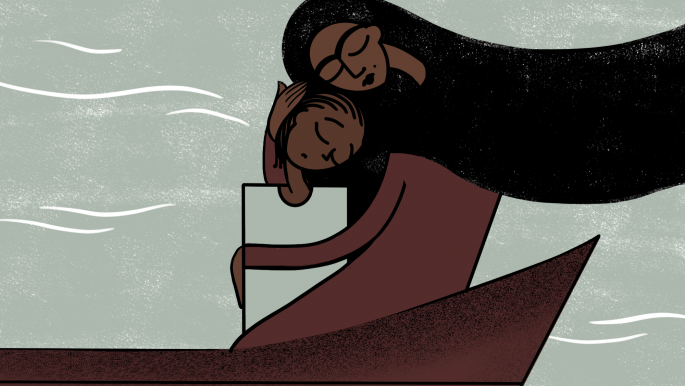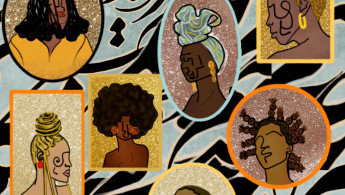The Collective: How a new initiative seeks to amplify Black and Afro-Iranian voices
"Are you kidding me? This girl doesn't even have a beautiful face, her hair is frizzy. And her skin is black, how much editing will we have to do to have her skin be lighter?"
Melika recalls the day with sadness; "I'll never forget that day. I looked down and lost my self-confidence," she bravely tells online audiences on the Collective for Black Iranians — a digital platform and non-for-profit organisation launched to amplify the voices and experiences of Black and Afro-Iranians.
Her story is just one of many the Collective have collected digitally through the 'Voices From Home' series. Each story delves into the unique nuances and challenges of navigating life from the perspective of Black Iranians.
Launched in August 2020 after the murder of George Floyd and the resurrection of the Black Lives Matter movement, Priscillia Kounkou-Hoveyda founded the platform alongside co-founders Alex D. Eskandarkhah, Homayoun Fiamor, sisters Pardis and Parisa Nkoy, and Norman Soltan Salahshour.
 |
Each story delves into the unique nuances and challenges of navigating life from the perspective of Black Iranians |  |
Frustrated by the absence of Black voices in the Iranian community and the media, the group came together to form a collective built on three fundamental pillars: Amplify, Advocate and Educate.
Co-founders and sisters Pardis and Parisa Nkoy were born in Salt Lake City, Utah to an Iranian mother and a Congolese father. Pardis recalls a feeling of isolation in regards to her Iranian culture when growing up, and although she felt so much a part of the culture, felt she was never fully accepted into it.
"It led me to distance myself from the community, but then I met Priscillia through Facebook and over time I realised that not only are there other people whose families are from where mine are from, but that there are also Black Iranians in Iran," she told The New Arab.
"It was a feeling of connection and that I was part of something bigger than me," Pardis went on to say, a feeling she hopes that the Collective with bring to fellow Black Iranians around the globe.
 |
|
| One of the core messages the Collective wanted to hit home with audiences is that Blackness is transnational [Khyzran and Walladee. Produced by the Collective with resident artist Mina Jafari] |
Blackness is transnational
One of the core messages the Collective wanted to hit home with audiences is that Blackness is transnational.
In Iran, southern coastal regions of the country such as Hormozgan, Khuzestan, and Sistan and Baluchestan are where Afro-Iranian communities reside. There are also many Black and Afro-Iranians living all around the world in the global diaspora.
Some well-known Black and Afro-Iranians include footballer Dennis Walker, the first Black man to play for Manchester United, and Yara Shahidi, an American actress, model, and activist who first rose to fame for her role in the US sitcom Blackish.
Despite this, Black and Afro-Iranians often find themselves perceived as foreigners.
Co-founder Alex D. Eskandarkhah is Canadian-Iranian and opened up about his experience of travelling to Iran as a young man.
"A lot of people were saying things like look at this khareji (foreigner) and then I started speaking Farsi and they were like, 'Oh! Where did you learn how to speak Farsi?'" he told The New Arab.
 |
A lot of people were saying things like look at this khareji (foreigner) and then I started speaking Farsi and they were like, 'Oh! Where did you learn how to speak Farsi? |  |
Alex's time spent in Iran where he met other Black Iranians went on to really shape his identity.
"Until then I was already really conscious of my Blackness, I grew up in inner city Toronto, all my friends are Black, so in my head I was just another Black guy, but going to Iran and seeing a bunch of other people in Iran who are like me, my family, my teammates, who are Black Iranians — it really opened my eyes to the transnationality of Blackness and made me want to understand my roots and history," he added.
A history of Black people in Iran
The histories of how Black people came to be in Iran are varied and complex.
|
||
"They didn't just pop up out of nowhere, there was the Indian Ocean slave trade, there was people going out there to work, it [the Collective] is highlighting the good and bad of Black people's journeys and putting them at the forefront of representation," Alex told The New Arab.
In order to rectify the lack of accessible information on these stories of migration, the Collective works with resident historian Beeta Baghoolizadeh to produce fascinating histories on the subject digitally on their website and social media platforms.
One such story is that of Narges, a young girl who found herself illegally kidnapped and enslaved in Tehran in 1906 as a slave, despite having status as a free woman.
Told through beautiful animated illustrations, the series follows her story of strength and resilience.
Black is beautiful: Defying Western centric beauty standards
Racism against Black and Afro-Iranians takes many forms. Some issues the founders point to include the sighting of men in blackface in Iran around Nowruz celebrations as they dress up as the character Haji Firuz, as well as ignorance about Blackness and issues of race more broadly.
Another issue is the prevalence of Western-centric and Caucasian beauty standards among Iranians, an issue that Priscillia has faced on a personal level.
"I was the only Black girl at school, the only Black girl at Eid Nowruz, and you become prone to all sorts of comments from children who do not understand Blackness," said Priscillia.
"They asked me questions such as: 'I don't understand why your skin is black?' 'Is it because you stayed under the sun for too long?' 'It's dirty, I don't understand where it's come from?'.
While living in London, Priscillia was approached by an Iranian woman who heard her speaking on the phone in Farsi.
"She told me 'you should marry a white man so that your children will be lighter skinned,' this is what we have to navigate as Black folks in a world where being lighter is this beauty criteria," she told The New Arab.
The Collective launched the "Black is beautiful" series as an artistic response to the intersection of Blackness, Iranianness, Iran and Africa.
"It's an invitation into seeing Blackness within Iranian identity," says Priscillia.
The Collective say the response to this campaign and their work more broadly has been mostly very positive, with the Instagram page already has over 10k followers after just six months.
They hope to expand further into different mediums, with the possibility of a documentary, and spread their message and support for Black and Afro-Iranian voices wider into the world.
Sahar Esfandiari is a British-Iranian writer focused on the Middle East and its diaspora
Follow her on Twitter: @saharesfandiari


![President Pezeshkian has denounced Israel's attacks on Lebanon [Getty]](/sites/default/files/styles/image_684x385/public/2173482924.jpeg?h=a5f2f23a&itok=q3evVtko)



 Follow the Middle East's top stories in English at The New Arab on Google News
Follow the Middle East's top stories in English at The New Arab on Google News


